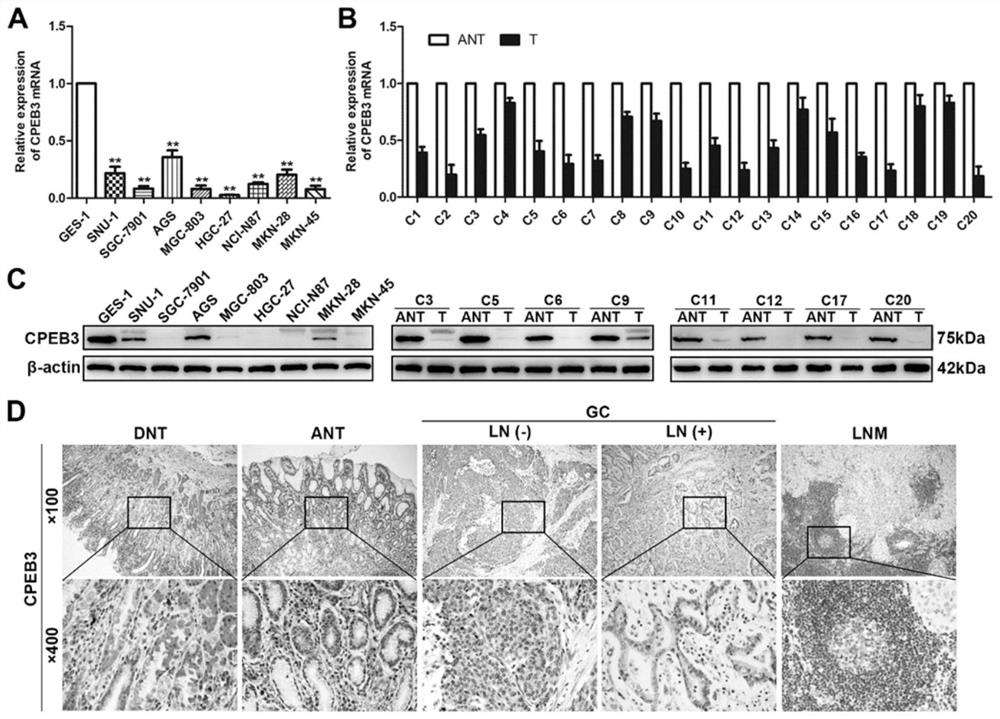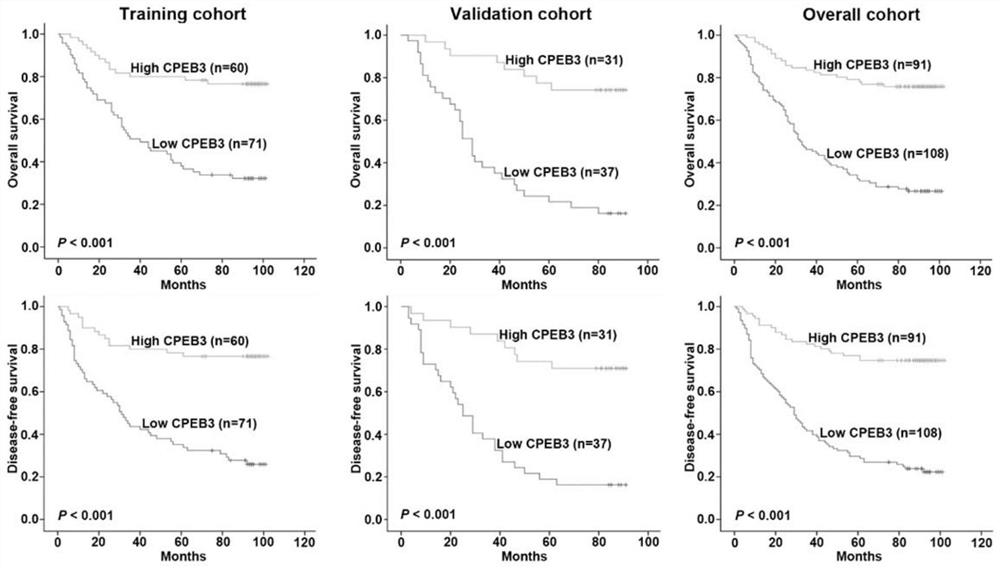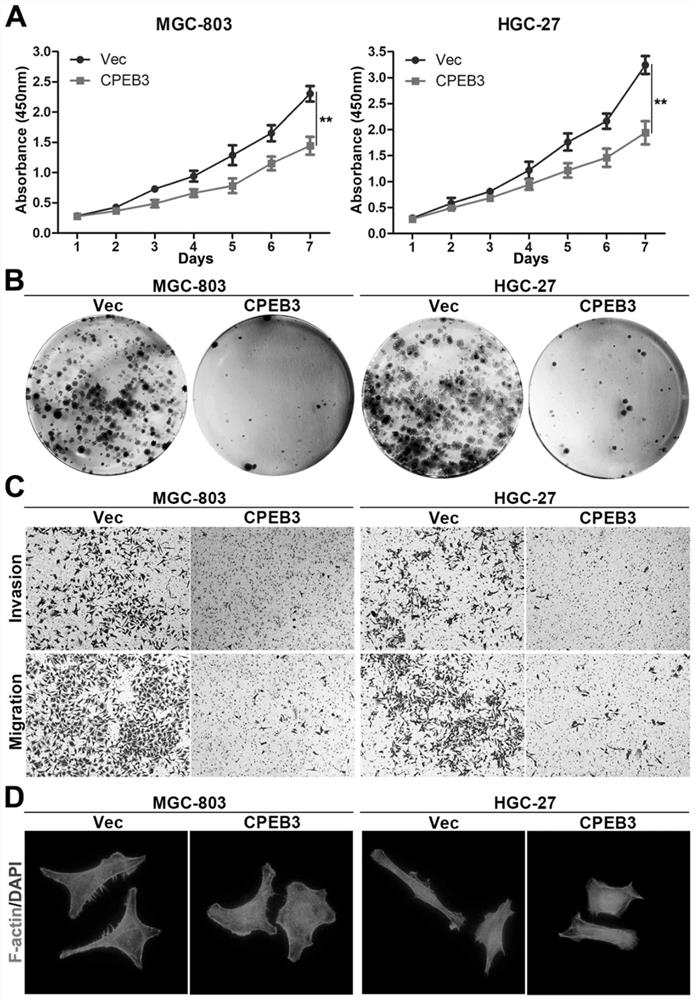Application of AAV9-CPEB3 in preparation of medicine for treating gastric cancer
1. The technology of AAV9-CPEB3 and AAV9, applied in the field of biomedicine, can solve the problems of cancer cell proliferation, invasion and metastasis of gastric cancer cells, etc., and achieve the effect of improving the quality of life, increasing the chance of cancer recurrence, and easy recurrence
- Summary
- Abstract
- Description
- Claims
- Application Information
AI Technical Summary
Problems solved by technology
Method used
Image
Examples
Embodiment 1
[0030] Firstly, the gastric cancer cell lines SNU-1, SGC-7901, AGS, MGC-803, HGC-27, NCI-N87, MKN-28, MKN-45 and the human gastric mucosal cell line GES-1 were selected for fluorescence real-time Quantitative PCR detection and Western-blot experiments showed that the expression of CPEB3 messenger RNA and protein was significantly down-regulated in gastric cancer cell lines ( figure 1 A, C).
[0031] Then, 20 fresh gastric cancer tissues and corresponding adjacent non-rumen mucosal tissues were randomly collected from the patients who underwent gastric cancer resection in the First Affiliated Hospital of Sun Yat-Sen University and were confirmed to be gastric adenocarcinoma after surgery, and the tissues were analyzed separately. Fluorescent real-time quantitative PCR detection and Western-blot experiments showed that the expression of CPEB3 messenger RNA and protein was significantly down-regulated in gastric cancer tissues ( figure 1 B,C).
[0032] Subsequently, 15 cases of...
Embodiment 2
[0034] From January to December 2012 in the First Affiliated Hospital of Sun Yat-sen University in the Department of Gastrointestinal Surgery, 160 patients with gastric cancer were randomly selected; from January to December 2013 in the First Affiliated Hospital of Sun Yat-sen University Among the patients undergoing gastric cancer resection in gastrointestinal surgery, 80 patients with gastric cancer were randomly selected. According to certain inclusion and exclusion criteria, 131 patients with gastric adenocarcinoma were finally included in the training cohort, and 68 patients were included in the validation cohort.
[0035] Detailed collection of clinicopathological data, surgical data and postoperative follow-up data of the above patients, such as patient gender, age, comorbidities, serosa invasion, tumor location, operation method, operation time, hemostasis method, intraoperative bleeding and blood transfusion volume , postoperative complications, perioperative death, r...
Embodiment 3
[0076] The following in vitro experiments were carried out on CPEB3 to further confirm its effect on gastric cancer.
[0077] 1. CPEB3 can inhibit the proliferation ability of gastric cancer cells in vitro
[0078] The proliferation ability of gastric cancer cells is often closely related to the growth of gastric cancer. In order to know whether CPEB3 is related to the proliferation ability of gastric cancer, multiple experiments were used to confirm this situation. The growth curve of CCK8 cells is as follows image 3 A shows that the proliferation ability of gastric cancer cells MGC-803 and HGC-27 decreased significantly after overexpression of CPEB3. Such as image 3 B shows that the cell colony formation assay showed that the colony numbers of gastric cancer cells MGC-803 and HGC-27 were significantly reduced after overexpression of CPEB3. These two experiments both confirmed that CPEB3 has a significant relationship with the proliferation ability of gastric cancer, and...
PUM
 Login to View More
Login to View More Abstract
Description
Claims
Application Information
 Login to View More
Login to View More - R&D
- Intellectual Property
- Life Sciences
- Materials
- Tech Scout
- Unparalleled Data Quality
- Higher Quality Content
- 60% Fewer Hallucinations
Browse by: Latest US Patents, China's latest patents, Technical Efficacy Thesaurus, Application Domain, Technology Topic, Popular Technical Reports.
© 2025 PatSnap. All rights reserved.Legal|Privacy policy|Modern Slavery Act Transparency Statement|Sitemap|About US| Contact US: help@patsnap.com



